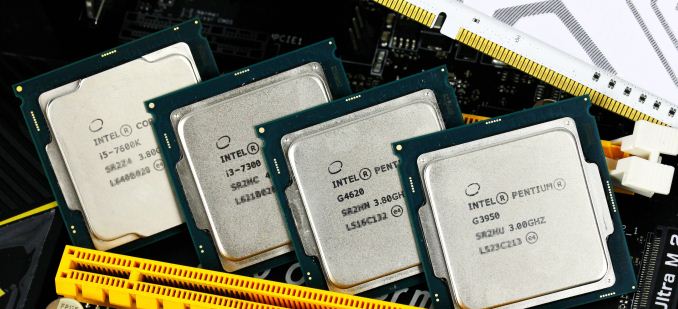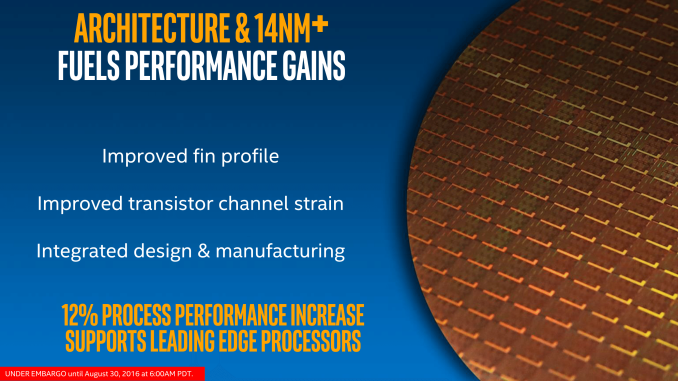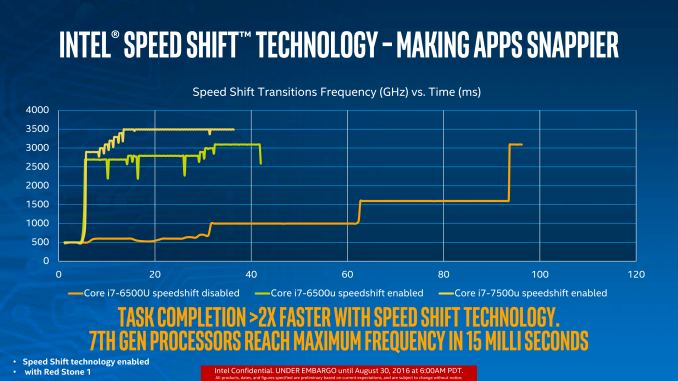Desktop Kaby Lake-S i7/i5 Lineup and 200-Series Chipsets Leaked
by Ian Cutress & Anton Shilov on October 31, 2016 10:00 AM EST- Posted in
- CPUs
- Intel
- 14nm
- Kaby Lake
- 200-series

Intel has already started to sell low-power dual-core Core i5/i7 Kaby Lake microprocessors for notebooks, but desktop parts with four cores and high frequencies are due in early 2017, as Intel announced back at IDF and the Kaby Lake-Y/U launch. In advance of the desktop launch, as is typical with how CPUs are launched, Intel has to send out qualification and near-retail samples to partners for pre-testing of release systems. Typically this is kept under wraps, without official public announcements (it's up to you how many of the leaks you want to believe), but late last week Intel sent out a 'Product Change Notification' through its online/public channels, with details about a good portion (no way to tell if it is all the SKUs) of Intel's Core i7 and Core i5-7000 series parts.
Within the PCN, Intel notified its customers about an additional assembly/packaging site for its desktop Kaby Lake-S chips in Vietnam and therefore had to disclose model numbers of the CPUs as well as some of the specifications. In addition, in a separate PCN detailing package adjustments for how chipset ICs are shipped, it would seem that Intel has also mentioned names of its upcoming 200-series chipsets.
According to Intel’s document for partners, the company intends to release at least 11 quad-core processors for desktops based on the Kaby Lake microarchitecture in Q1. What is noteworthy is that the company wants its customers to get ready to receive the first shipments of the KBL-S chips assembled in Vietnam starting from November 4, 2016, this week (which means that the final specs of the new processors have been set and will only be changed in extreme circumstances). The initial KBL-S lineup would seem to include three Core i7 SKUs, seven Core i5 CPUs as well as one Xeon E3 v6 product. (The fact that a Xeon v6 is included in this is interesting, given that Intel removed standard chipset support for Xeon E3 CPUs with Skylake and v5, meaning that both consumer and enterprise platforms are due to land in January.)
All the Kaby Lake-S processors will use the B0 stepping of the core, and will have 100-300 MHz higher base frequency compared to their Skylake-S counterparts. The PCN does not explicitly state the TDP, however we do not expect much to change given the slightly improved 14+ nm technology and the increased frequencies (same thing applies to cache size, which has been consistent for several generations). We have already observed that mobile Kaby Lake CPUs have higher clock rates compared to their predecessors due to enhancements of Intel’s 14+ nm process technology, and we see that their desktop brethren also have improvements on this front. We do not have the final Turbo frequencies at hand, but we expect them to be considerably higher than the base clock rates.
| Basic Specifications of Quad-Core Intel Core i5/i5 and Xeon E3 | |||||||||
| Kaby Lake-S | Skylake-S | ||||||||
| Model | Cores /Threads |
Freq. (Base) |
TDP | Product Code |
S-Spec | Model | Freq. (Base) |
||
| i7-7700K | 4/8 | 4.2 GHz | 95W | CM8067702868535 | SR33A | i7-6700K | 4.0GHz | ||
| i7-7700 | 3.6 GHz | 65W | CM8067702868314 | SR338 | i7-6700 | 3.4GHz | |||
| i7-7700T | 2.9 GHz | 35W | CM8067702868416 | SR339 | i7-6700T | 2.8GHz | |||
| i5-7600K | 4/4 | 3.8 GHz | 95W | CM8067702868219 | SR32V | i5-6600K | 3.5GHz | ||
| i5-7600 | 3.5 GHz | 65W | CM8067702868011 | SR334 | i5-6600 | 3.3GHz | |||
| i5-7600T | 2.8 GHz | 35W | CM8067702868117 | SR336 | i5-6600T | 2.7GHz | |||
| i5-7500 | 3.4 GHz | 65W | CM8067702868012 | SR335 | i5-6500 | 3.2GHz | |||
| i5-7500T | 2.7 GHz | 35W | CM8067702868115 | SR337 | i5-6500T | 2.5GHz | |||
| i5-7400 | 3.0 GHz | 65W | CM8067702867050 | SR32W | i5-6400 | 2.7GHz | |||
| i5-7400T | 2.4 GHz | 35W | CM8067702867915 | SR332 | i5-6400T | 2.2GHz | |||
| E3-1205v6 | ?/? | 3.0 GHz | ? | CM8067702871025 | SR32D | - | - | ||
| Additional Info from Other Sources | |||||||||
| i3-7300* | 2/4 | 4.0 GHz | 65W | ? | SR2MC | i3-6300 | 3.8 GHz | ||
| Pentium G4620* | 2/2 | 3.8 GHz | 51W | ? | SR2HN | Pentium G4520 | 3.6 GHz | ||
| Pentium G3950* | 2/2 | 3.0 GHz | 51W | ? | SR2MU | Pentium G3920 | 2.9 GHz | ||
*CPU details taken from this piece at PCOnline
Aside from the 14+ process offering higher frequencies, the base microarchitecture of Kaby Lake-S, as explained at the release of Kaby Lake-Y/U in September, is essentially the same as Skylake. However, on top of increasing the frequencies, Intel is also adding in Speed Shift v2 which allows for much quicker adjustments in CPU frequency over Skylake (down to 10ms rather than 30ms).
It remains to be seen is whether the new 14+ process technology will also enable considerably higher overclocking potential compared to existing CPUs. If it does, then the new chips have a chance to become rather popular among enthusiasts, potentially toppling the i7-2600K as a long term favorite.
It might be noted is that Intel’s Kaby Lake-S will have to compete not only against their predecessors, but also against AMD’s Zen products due in Q1. That being said, some would argue that given AMD's recent presentation of certain benchmark metrics, Zen is geared more towards the high-end desktop crowd. Nevertheless, it looks like early 2017 is going to be an interesting time for microprocessors.
200-Series Chipsets
In addition to model numbers of its Kaby Lake CPUs, Intel also revealed the names of its 200-series chipsets in another document it sent to partners. As expected, the lineup will include the Z270 PCH for enthusiast-class PCs with overclocking capabilities; Q270, H270 and H250 for mainstream systems and B250 for office/business computers.
| Intel 200-Series Chipsets | ||||||
| Name | Socket | Stepping | Product Code | S-Spec | ||
| Intel H270 | LGA1151 | A0 | GL82H270 | SR2WA | ||
| Intel Z270 | GL82Z270 | SR2WB | ||||
| Intel B250 | GL82B250 | SR2WC | ||||
| Intel Q250 | GL82Q250 | SR2WD | ||||
| Intel Q270 | GL82Q270 | SR2WE | ||||
| Intel C422 | LGA1151? | A0 | GL82C422 | SR2WG | ||
| Intel X299 | ?!? | A0 | GL82X299 | SR2Z2 | ||
Also in the list of chipsets were a couple of unknowns as well.
Listed in the PCN is C422, which because it has a 'C' in the name means that this is typically geared towards workstations and Xeon platforms. This may be in line with the E3-1205 v6 CPU SKU as seen in the processor list.
Also is X299, which really throws up a few question marks. The X-series chipsets are typically for Intel's High-End Desktop Platform (HEDT), and we've had X58, X79 and X99 in the last decade, from Nehalem up to Broadwell-E which was released back in May. This means either one of two things - either Intel is bringing the X nomenclature to Kaby Lake, the mainstream platform, or this is the next chipset for HEDT and the future Skylake-E series of processors. The first option in making X299 a Kaby Lake-related platform seems a little odd. However the second one, with Skylake-E, makes sense. After X99, the X119 name doesn't have the same marketability (if Intel was to keep parity with number jumps), but by pushing Skylake-E onto the 200-series naming as X299, it moves both mainstream and HEDT chipset naming strategies onto the same track. Note that we don't have a time-frame for Skylake-E as of yet.
Intel’s motherboard customers, given the Q1 launch, must be ready to receive the 200-series PCH ICs on new reels. According to the PCN, these will come with additional protections bands starting from December 2, 2016. Intel may or may not announce the whole 200-series (not X) lineup at CES, given this late in the day adjustment to core components for the motherboards.
As for improvements of the Intel 200-series chipsets, we are still waiting on official confirmation as to exactly what to expect. Various unconfirmed leaks have indicated additional PCIe 3.0 chipset lanes, some new platform features and support for Intel’s Optane SSDs, however we will be here for the official launch when the time comes. It might be worth noting that almost all the motherboard manufacturers have now formally announced new 100-series BIOS support for Kaby Lake CPUs, meaning not all enthusiasts will have to get new motherboards.


















72 Comments
View All Comments
StevoLincolnite - Monday, October 31, 2016 - link
My 3930K does 5ghz happily... And would give these Kaby Lake chips a good run for it's money, despite being 5 years old.Samus - Tuesday, November 1, 2016 - link
Overclocking headroom has steadily decreased since Sandy Bridge, in part due to higher default frequencies, and in part (until Devil's Canyon on Haswell) due to the heat spreader mating.Even with tweaked fins, 14nm+ isn't going to yield additional overclocking headroom over Skylake (which was already a pretty mature 14nm process) but it will obviously give better default speed.
My Haswell i5-4690k maxed out at the same 4.5GHz my Sandy i5-2500k did. In comparison, I can't get my friends Skylake i5-6600k stable at even 4.4GHz on a really good cooler and motherboard, so just luck of the draw I guess, and kind of unfortunate when you consider the i5-6600k has an identical clock speed to the i5-4690k...
The IPC improvement, clock for clock, since Sandy Bridge hasn't been all that good up through Skylake. Sandy Bridge offered a good jump from Nehalem but since then the generational performance has been around 2% average, making a 4.5GHz i5-6600k about 8% faster than a 4.5GHz i5-2500k, albeit much more energy efficient on a newer platform.
And let's not ignore the elephant in the room here. The benefit of new Core chips are ALWAYS the platform. CPU performance simply hasn't been improving and isn't the selling point of a new PC. It's the I/O.
If my old X58 system had native USB 3.0, m.2, PCIe 3.0 and better energy efficiency, I'd still have a Core i7-950.
Meteor2 - Tuesday, November 1, 2016 - link
That's being a bit disingenuous; generational IPC improvements have been more than 5%, compounding to 25% from Sandy Bridge to Skylake.Byte - Tuesday, November 8, 2016 - link
They don't call it Silcone Lottery for no reason. You can see the rarity of 4.7+ by the prices. I played with 5 delidded Skylakes 4700k and 4.6 was the max of one of them and thats with hefty bump of 1.375v. Temps don't reach much above 80C at full load on a Hyper 212.ryrynz - Tuesday, November 1, 2016 - link
I know they have improved the packaging. This is overall a fair upgrade to Skylake all and all.The GPU side of things isn't getting much love, seems few care about that.
Meteor2 - Tuesday, November 1, 2016 - link
Intel doesn't have particularly great GPU tech and it sharing 90-odd Watts of heat removal with the CPU doesn't give great performance. I don't understand the fuss about Iris -- it's useless.Morawka - Monday, October 31, 2016 - link
not necessarily, they could increase performance without increasing power if the improved fin pitch is to be belived.BrokenCrayons - Monday, October 31, 2016 - link
On the bright side, as Kaby Lake doesn't add a lot of performance, lots of people that are currently running "good enough" processors won't be as compelled to upgrade. Those C2D and 1st/2nd generation Core iX CPUs remain relevant.Ej24 - Monday, October 31, 2016 - link
C2D is most certainly not relevant. It's missing many instruction sets and accelerated encryption. I recently put my last C2D system out of it's misery. A dual core Skylake at 3Ghz is the equivalent of a C2D at probably 5Ghz (which is obviously impossible). The 5-10% clock for clock increase per generation really adds up after 7+ generations. It's almost multiplicative at this point when compared to those old architectures. Not to mention the perf. per watt is off the charts these days by comparison.Everyone complains, "oh it's just another 300mhz increase" but that +300mhz for Kaby Lake is the same as +350mhz for Skylake, +400mhz for Broadwell, +475mhz for Haswell, and so on, by the time you get back to Nehalem it's just laughable. (These of course aren't real numbers, it's just to make a point). 4ghz Kaby lake does not equal 4ghz Haswell. You simply can't compare clock speeds between generations.
BrokenCrayons - Monday, October 31, 2016 - link
No arguments about the incremental increases in performance adding up over time or about the added features that are useful to a lot of people. However, it does really depend on workloads. My daily use computer at home is a Gateway MA8 laptop with a C2D T2310 at 1.46GHz and it's perfectly adequate for the time being. Yup, I'm not going to push out any high end games on the old Intel x3100 graphics card and it takes about 25 seconds to boot up thanks to the 5400 RPM 500GB hard drive, but I don't see myself buying a replacement for at least another year. I could see wanting an upgrade if I was still using my Atom n270 Eee PC as a primary box. Web browsing is a pretty miserable experience on it, but the T2310 is more than enough for me.